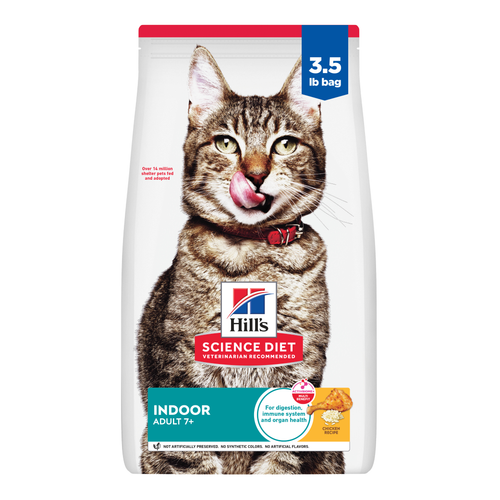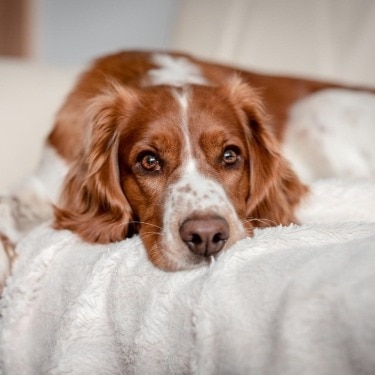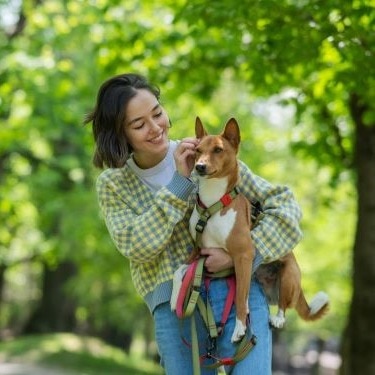
-
Find the right food for your petTake this quiz to see which food may be the best for your furry friend.Find the right food for your petTake this quiz to see which food may be the best for your furry friend.Featured products
 Adult Large Breed Chicken & Barley Recipe Dog Food
Adult Large Breed Chicken & Barley Recipe Dog FoodSupports healthy joints, lean muscle, and beautiful coat for large breed dogs
Shop Now Hill's Science Diet Adult Chicken & Beef Entrée Dog Food
Hill's Science Diet Adult Chicken & Beef Entrée Dog FoodChicken & Beef Entrée in a delicious loaf with complete & balanced nutrition to help keep adult dogs active and healthy
Shop Now Adult Chicken & Barley Recipe Dog Food
Adult Chicken & Barley Recipe Dog FoodSupports lean muscle and beautiful coat for adult dogs
Shop NowFeatured products Adult 7+ Indoor Chicken Recipe Cat Food
Adult 7+ Indoor Chicken Recipe Cat FoodSupports energy level and beautiful fur in mature indoor cats
Shop Now Adult Turkey & Liver Entrée Cat Food
Adult Turkey & Liver Entrée Cat FoodPrecisely balanced nutrition with the delicious taste of minced turkey & liver to help fuel the energy needs of cats during the prime of their life
Shop Now Senior Vitality Adult 7+ Tuna & Vegetables Stew
Senior Vitality Adult 7+ Tuna & Vegetables StewImproves Everyday Ability to Get Up & Go
Shop Now -
Dog
- Dog Tips & Articles
-
Health Category
- Weight
- Food & Environmental Sensitivities
- Urinary
- Digestive
- Joint
- Kidney
-
Life Stage
- Puppy Nutrition
- Adult Nutrition
- Senior Nutrition
Cat- Cat Tips & Articles
-
Health Category
- Weight
- Skin & Food Sensitivities
- Urinary
- Digestive
- Kidney
-
Life Stage
- Kitten Nutrition
- Adult Nutrition
Featured articles How to Properly Mix Wet & Dry Pet Foods
How to Properly Mix Wet & Dry Pet FoodsAn Orange cat eating from a bowl filled with mixed food
Read More The Science Behind Our Love for Pets
The Science Behind Our Love for PetsLearn the scientific reasons why we have such strong connections with our pets, and what science says about the love between humans and our furry friends.
Read More What Is Littermate Syndrome? Pet Adoption Guide
What Is Littermate Syndrome? Pet Adoption GuideLearn more about littermate syndrome in dogs and cats and how to successfully navigate adoption and early socialization processes.
Read More -


Dog breeds are classified by their prominent physical characteristics. There are broad classifications, like small breeds and large breeds, which can help pet parents and veterinarians differentiate the sizes between Chihuahuas and Great Danes. However, in addition to these broad size-based classifications, dog breeds with specific common physical characteristics may be further separated into smaller groupings, such as brachycephalic (short-nosed), deep-chested or chondrodystrophic breeds.
Chondrodystrophic dog breeds are characterized by their short legs in comparison to their body size and length. This trait is a primary requirement for the breed standard of numerous dog breeds and is a product of their genetics. The genetics resulting in this body type primarily affect the long bones of dogs. It's due to the growth plates of these bones calcifying earlier in development than other breeds, thus producing shortened bones with a curved appearance. Read on to learn more about which breeds are considered chondrodystrophic and how to care for dogs who fall under this classification.
Types of Chondrodystrophic Breeds
Chondrodystrophic dog breeds are separated into their own group not just because of their short legs, but because they share common notable physical characteristics as well as health concerns. The Dachshund is the classic representative of chondrodystrophic dog breeds. Other popular dog breeds in this group include:

Health Concerns for Chondrodystrophic Dog Breeds
As adorable as the chondrodystrophic dog breed is with their short legs, they're no stranger to health concerns. Some concerns include:
- Intervertebral Disc Disease (IVDD): Type I IVDD is common in chondrodystrophic breeds and usually affects young to middle-aged dogs. IVDD in dogs is often characterized by the loss of water and calcification of the disc material that sits between the bones of the back. This can lead to back pain. Signs of this disease tend to occur suddenly. Treatment may involve medications and rest, or in more severe cases, surgery to remove the disc material which is placing pressure on the spinal cord.
- Angular Limb Deformities: Some degree of angular limb deformity is part of what gives these chondrodystrophic dog breeds their distinctive short-legged appearance. This is considered normal for these breeds. But, in some rare cases, surgery may be necessary if the angular limb deformity results in pain.
- Ocular Disorders: Many of the chondrodystrophic breeds are genetically predisposed to ocular disorders, such as cataracts, glaucoma and retinal degeneration. But these conditions can occur in other breeds as well. Genetic tests for some of these conditions are available. Talk to your veterinarian about testing of a prospective new puppy or their parents.


Tasty Tips
Keeping Chondrodystrophic Dog Breeds Healthy
When it comes to caring for the chondrodystrophic dog breed and keeping them healthy, you'll want to keep their diet, exercise, spinal stress and routine exams in mind.
Nutrition
Eating the appropriate amount of high-quality pet food will help your pup maintain a healthy weight, which is very beneficial for a healthy back. Pet parents should measure food with a measuring cup and the amount fed should be based on the dog's weight as well as their body condition. If you're not sure what or how much to feed your pet, reach out to your vet.

Exercise
Regular exercise is also very important in maintaining a healthy weight and appropriate muscle mass for your dog. Exercise results in less stress overall on the body and joints while providing great mental stimulation for your dog. Here are some tips for getting your dog their appropriate amount of exercise.
Limit Stress on the Spine
Since chondrodystrophic dog breeds are prone to IVDD, limiting stress on the spine is important. Some pet parents may even decide to use a harness instead of a neck collar for walks to distribute their body weight over the chest versus just the neck. Others may try to limit jumping on and off of furniture and beds. Using doggie stairs for getting on and off of furniture can be helpful in encouraging cuddly bonding time with your pet while reducing unwanted stress on their spine.
Visit the Vet Regularly
Routine physical examinations with a vet help both the vet and pet parent address any health concerns as soon as they arise. Regular visits can also help you and your pet to form a bond with your vet as they partner with you to keep your dog healthy.
Chondrodystrophic breeds are some of the most popular dogs among pet parents as those cute short legs are hard to resist! However, it's important that pet parents are aware of the common health concerns among these dogs so they can provide the best care possible. Through a combination of a great nutrition, routine exercise and regular checkups with your vet, you can give a chondrodystrophic dog a long, enjoyable life with you and your family!


Jessica Seid is an emergency veterinarian practicing in the New England area. She is a graduate of the North Carolina State College of Veterinary Medicine and has been in the field for more than a decade. When she's not helping patients, she enjoys spending time with her husband, daughter and French bulldog.
Related products

Supports healthy joints, lean muscle, and beautiful coat for large breed dogs

Supports lean muscle and beautiful coat for adult dogs

Chicken & Barley Entrée in a delicious loaf with great taste and precisely balanced nutrition to support 5 essential building blocks for lifelong health

Chicken & Beef Entrée in a delicious loaf with complete & balanced nutrition to help keep adult dogs active and healthy
Related articles

Learn how to help keep your dog's immune system in tip-top shape, including nutritional immune system support for dogs and other strategies.

Wondering where can I buy a dog? Consider adoption and explore the pros and cons of adopting a dog from a breeder versus an animal shelter.

Discover how the field of dog science is giving us more and more insights into the inner workings of our furry best friends.

Your dog's coat and skin are a big part of your dog's overall health. Ensure you keep your dog's coat healthy, by following these simple tips.

Put your dog on a diet without them knowing
Our low calorie formula helps you control your dog's weight. It's packed with high-quality protein for building lean muscles, and made with purposeful ingredients for a flavorful, nutritious meal. Clinically proven antioxidants, Vitamin C+E, help promote a healthy immune system.
Put your dog on a diet without them knowing
Our low calorie formula helps you control your dog's weight. It's packed with high-quality protein for building lean muscles, and made with purposeful ingredients for a flavorful, nutritious meal. Clinically proven antioxidants, Vitamin C+E, help promote a healthy immune system.

